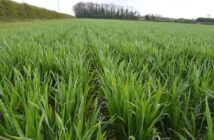Resistance to the ‘keystone’ herbicide group that includes 2,4-D has recently been confirmed in sowthistle (Sonchus oleraceus) from Victoria and South Australia and capeweed (Arctotheca calendula) from South Australia, with warnings for growers to be on the lookout in New South Wales and Queensland.
2,4-D resistance in sowthistle, pictured here near Warwick, QLD is a growing concern. Photo by AGRONOMO.
This brings the number of 2,4-D resistant species in Australia to four, joining wild radish (Raphanus raphanistrum) and Indian hedge mustard (Sisymbrium orientale).
“The two, new species have evolved in winter cropping in Victoria and South Australia following long histories of 2,4-D use,” said Andrew Storrie, Executive Officer of the Australian Glyphosate Sustainability Working Group.
“The Group I mode of action is the third leg of the weed control tripod of modern farming systems along with glyphosate and paraquat, with more than 200 million hectares sprayed globally each year.
“What is particularly concerning is one of the sowthistle populations is resistant to three Group I herbicides – 2,4-D, dicamba and clopyralid.
“Clopyralid is now widely used for the control of sowthistle, fleabane, and prickly lettuce (Lactuca serriola) across the farming system so spray survivors can’t be allowed to set seed.
“Growers north of Dubbo need to be on the lookout for Group I resistance developing in sowthistle and fleabane as well as brassica species such as turnip weed (Rapistrum rugosum), charlock (Sinapis arvensis) and African turnip weed (Sisymbrium thellungii).”
To meet the challenges Australian growers will face with the further development and spread of 2,4-D (and other Group I herbicides) resistance, the Australian Glyphosate Sustainability Working Group (AGSWG) has developed a page on its website dedicated to the management of Group I resistance via this link.
As well as containing important information on managing Group I resistance in Australia, the page has links to other sites with updates on the developing resistance problem and the better management of Group I resistance.
Internationally, 32 species are resistant to one or more Group I herbicides, including 24 broadleaf species, 5 grasses and 3 non-grass monocots.
“Despite being the first of the modern herbicides having been commercialised at the end of World War 2, and the first resistance being found in 1957, this group of herbicides continues to play a key role in modern agriculture, despite resistant weed populations continuing to develop”, Mr Storrie said.
“If you suspect decreasing levels of control with 2,4-D, MCPA or related herbicides, collect seed and get it tested across the Group I classes this season so you know what still works.”
Early control of Group I resistant weeds is an essential component of the management strategy along with full rates of herbicide, often followed by a second knock with a different mode of action. Broadening the rotation to allow the economic inclusion of non-herbicide management strategies such as manuring, hay and competitive pastures is also advised.
The AGSWG is supported by the Grains Research and Development Corporation (GRDC) and key research and development-based crop protection companies with an interest in the sustainability of glyphosate, paraquat and Group I herbicides.




